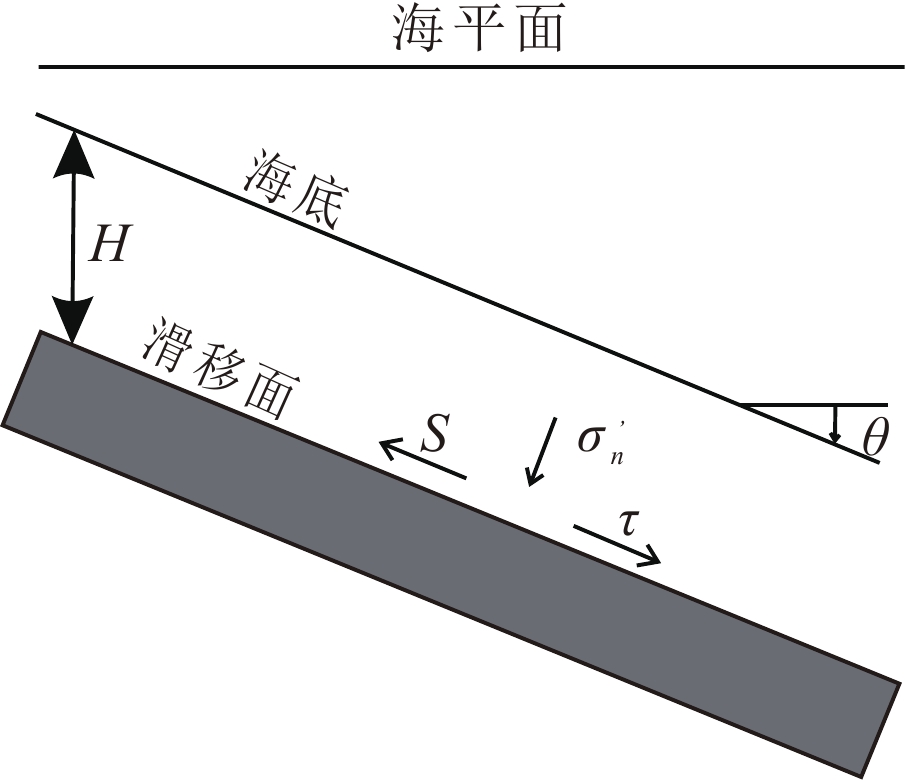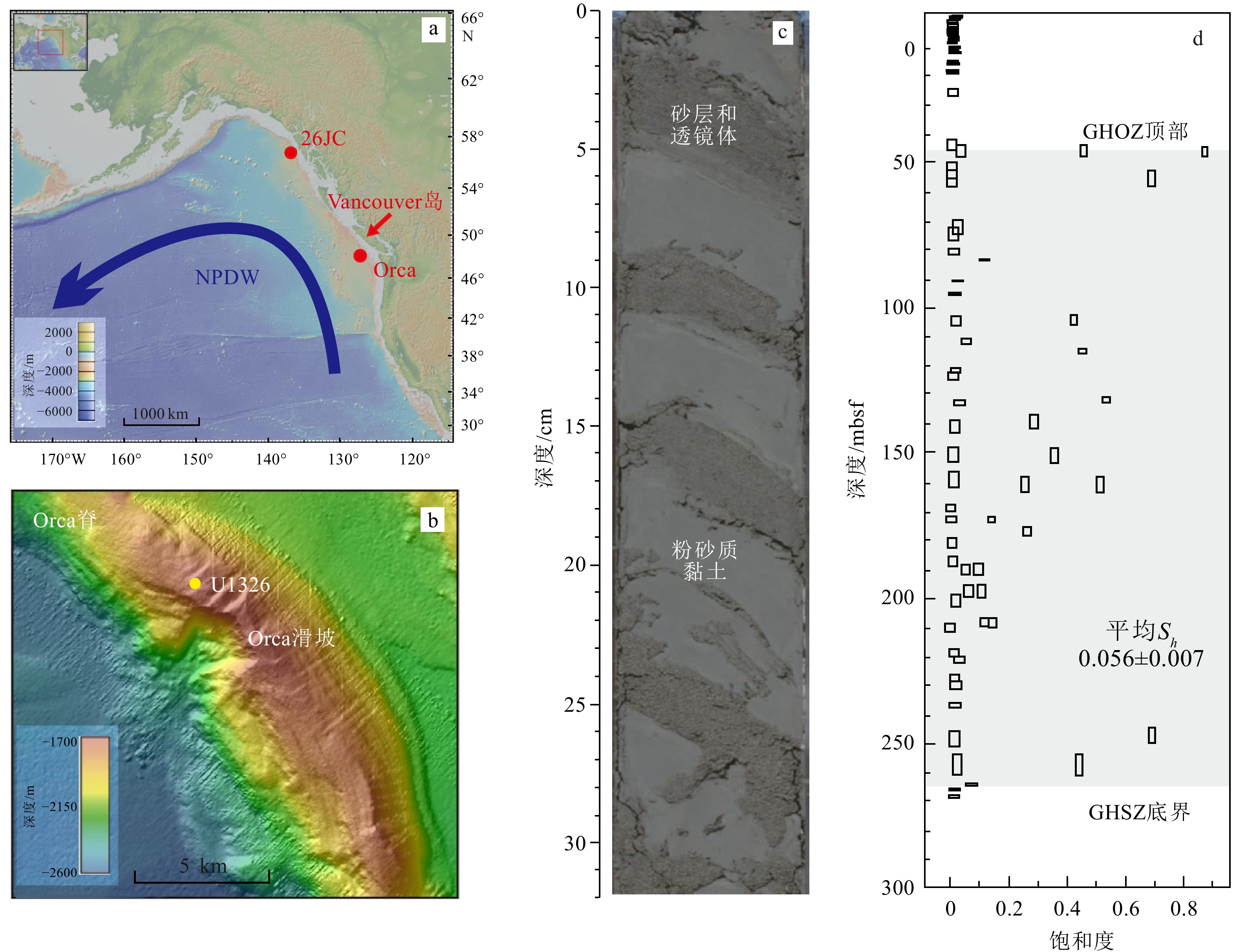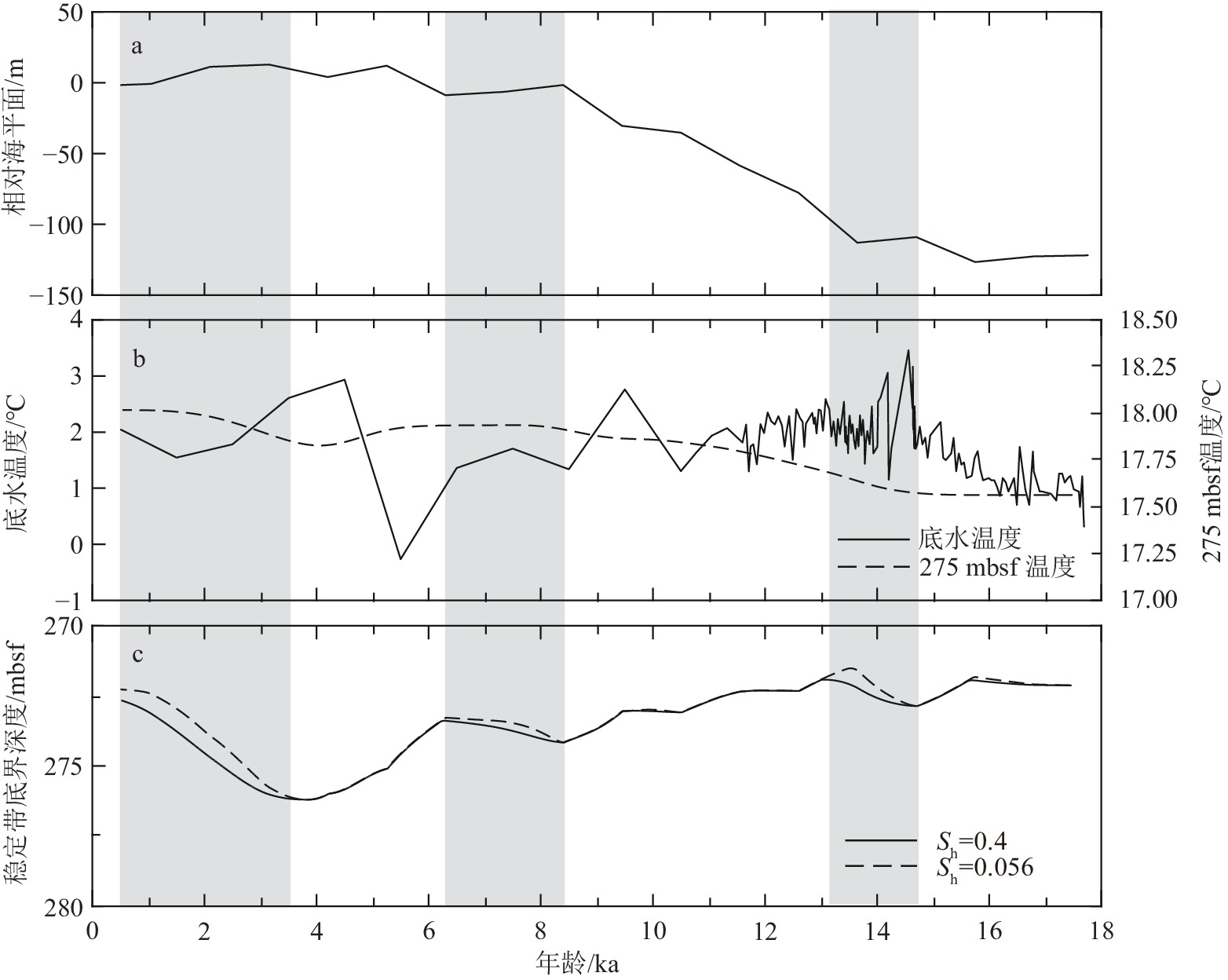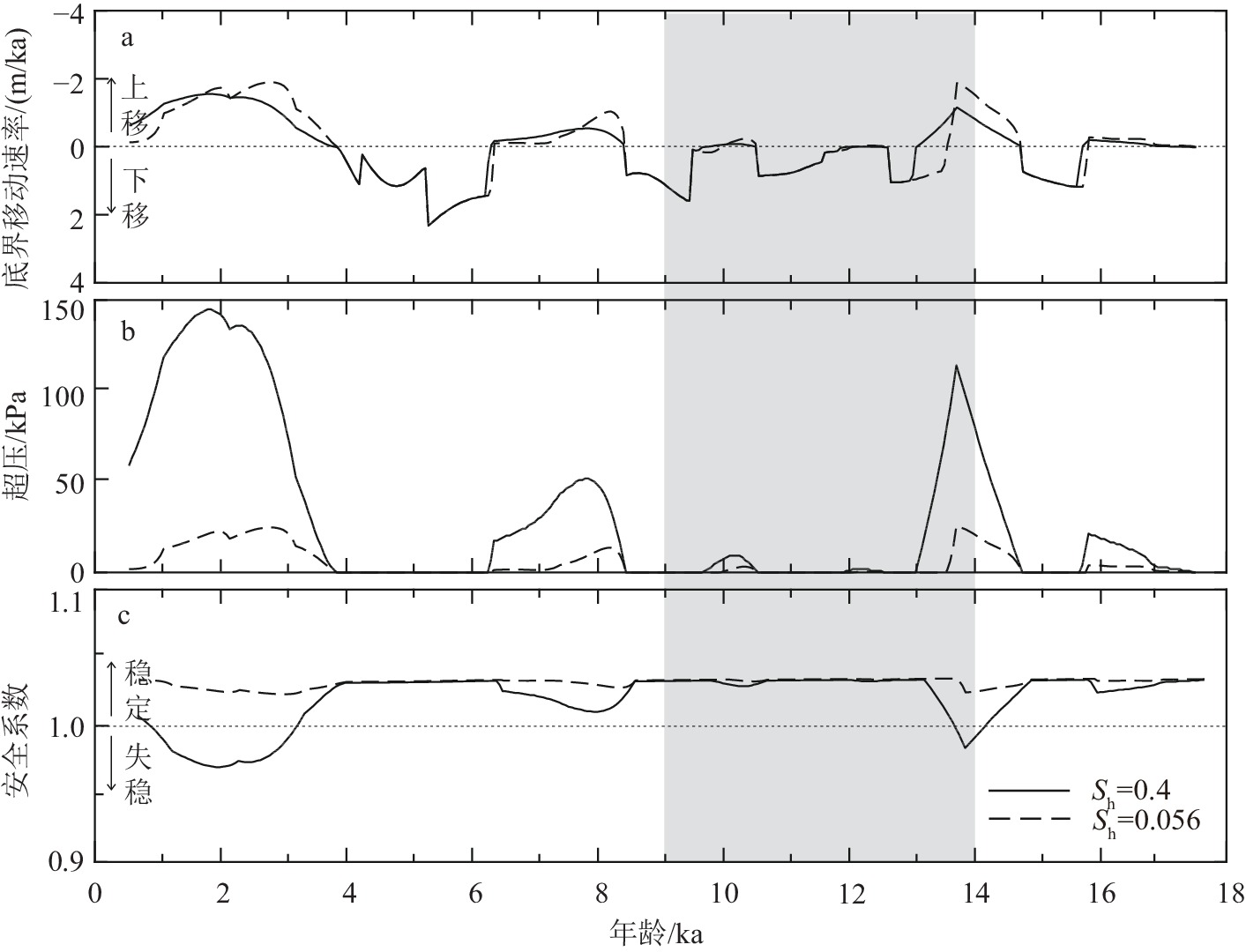Modelling of triggering of Orca submarine landslide, Cascadia margin, northeast Pacific
-
摘要:
海底温度和海平面变化可以引起海底天然气水合物分解,导致沉积物孔隙内形成超压,改变沉积物有效应力从而触发海底滑坡。本文建立了与此相关的海底滑坡产生的数值模型,并应用于东北太平洋Cascadia陆缘14~9 kaBP期间发生的Orca滑坡形成过程研究。模拟结果显示在最近18 ka海平面逐渐上升的大背景下,18~14 kaBP期间底水温度升高引起其后的天然气水合物稳定带底界快速上移,并在13.7 kaBP达到1.18 m/ka的高底界上移速率,此时Orca地区稳定带底界粗颗粒层内的高饱和度天然气水合物发生分解,产生114 kPa的流体超压,使地层安全系数显著小于1,触发海底滑坡。因此,海底温度升高引起高饱和度天然气水合物分解可能是东北太平洋Cascadia陆缘Orca海底滑坡的主要触发因素。
-
关键词:
- 海底滑坡 /
- 水合物分解 /
- 流体超压 /
- 滑坡触发机理 /
- Cascadia陆缘Orca滑坡
Abstract:Bottom-water temperature variations and eustatic sea-level fluctuations may cause decomposition of marine gas hydrate and excess pore pressure in sediment, which leads to a subsequent decrease in effective stress of the sediment, and eventually results in submarine landslides. A numerical modeling of the mechanism of such slope failure was developed herein, and was applied to the study of Orca Slide that occurred between 14 and 9 kaBP on the Cascadia margin in the northeast Pacific. The modeling results show that with the rising sea level in the last 18 ka, the base of hydrate stability zone (BHSZ) experienced a fast upward movement whose rising rate peaked to 1.18 m/ka at 13.7 kaBP due to continuous bottom-water warming during 18~14 kaBP. Meanwhile, an excess pore pressure of 114 kPa was formed in the coarse-grained layers in the BHSZ of Orca Slide as a result of gas hydrate decomposition, which then significantly reduced the factor of safety of the strata to less than 1, thereby triggering the submarine landslides. Therefore, highly saturated hydrate decomposition caused by the bottom-water temperature rise may be the main triggering mechanism of Orca submarine landslide.
-

-
[1] Nisbet E G, Piper D J W. Giant submarine landslides [J]. Nature, 1998, 392(6674): 329-330. doi: 10.1038/32765
[2] Luo M, Torres M E, Kasten S, et al. Constraining the age and evolution of the Tuaheni landslide complex, Hikurangi Margin, New Zealand, using pore-water geochemistry and numerical modeling [J]. Geophysical Research Letters, 2020, 47(11): e2020GL087243.
[3] Wharton W J L, Geikie A, Perry P, et al. Sub-oceanic changes: discussion [J]. The Geographical Journal, 1897, 10(3): 285-289. doi: 10.2307/1774772
[4] Herzer R H. Uneven submarine topography south of Mernoo Gap—the result of volcanism and submarine sliding [J]. New Zealand Journal of Geology and Geophysics, 1975, 18(1): 183-188. doi: 10.1080/00288306.1975.10426354
[5] Barrier A, Bischoff A, Nicol A, et al. Relationships between volcanism and plate tectonics: a case-study from the Canterbury Basin, New Zealand [J]. Marine Geology, 2021, 433: 106397. doi: 10.1016/j.margeo.2020.106397
[6] McIver R D. Role of naturally occurring gas hydrates in sediment transport [J]. AAPG Bulletin, 1982, 66(6): 789-792.
[7] Elger J, Berndt C, Rüpke L, et al. Submarine slope failures due to pipe structure formation [J]. Nature Communications, 2018, 9(1): 715. doi: 10.1038/s41467-018-03176-1
[8] 唐常锐, 徐秀刚, 孙秉才, 等. 天然气水合物分解诱发海底滑坡影响因素分析及致灾风险评价[J]. 海洋地质前沿, 2021, 37(5):14-21 doi: 10.16028/j.1009-2722.2021.021
TANG Changrui, XU Xiugang, SUN Bingcai, et al. Influence factors and risk assessment for seabed landslides induced by natural gas hydrate decomposition [J]. Marine Geology Frontiers, 2021, 37(5): 14-21. doi: 10.16028/j.1009-2722.2021.021
[9] Hance J J. Development of a database and assessment of seafloor slope stability based on published literature[D]. Doctor Dissertation of University of Texas, 2003.
[10] Mulder T, Cochonat P. Classification of offshore mass movements [J]. Journal of Sedimentary Research, 1996, 66(1): 43-57.
[11] Locat J, Lee H, Kayen R, et al. Shear strength development with burial in eel river margin slope sediments [J]. Marine Georesources & Geotechnology, 2002, 20(2): 111-135.
[12] 秦志亮, 孙思军, 谭骏, 等. 西沙群岛海域海洋地质灾害现状与对策[J]. 海洋开发与管理, 2014, 31(9):12-16 doi: 10.3969/j.issn.1005-9857.2014.09.03t
QIN Zhiliang, SUN Sijun, TAN Jun, et al. Current situation and countermeasures of marine geological disasters in the Xisha Paracel Islands [J]. Ocean Development and Management, 2014, 31(9): 12-16. doi: 10.3969/j.issn.1005-9857.2014.09.03t
[13] Chen Y M, Zhang L L, Liao C C, et al. A two-stage probabilistic approach for the risk assessment of submarine landslides induced by gas hydrate exploitation [J]. Applied Ocean Research, 2020, 99: 102158. doi: 10.1016/j.apor.2020.102158
[14] 陈泓君, 黄磊, 彭学超, 等. 南海西北陆坡天然气水合物调查区滑坡带特征及成因探讨[J]. 热带海洋学报, 2012, 31(5):18-25 doi: 10.3969/j.issn.1009-5470.2012.05.004
CHEN Hongjun, HUANG Lei, PENG Xuechao, et al. Discussion of characteristics and formation of landslide zones in the gas hydrate survey area of northwest continental slope, the South China Sea [J]. Journal of Tropical Oceanography, 2012, 31(5): 18-25. doi: 10.3969/j.issn.1009-5470.2012.05.004
[15] Yang L L, Wang J, Jiang Y H. Experimental study and numerical simulation of overlying layer soil failure caused by hydrate decomposition [J]. ACS Omega, 2020, 5(48): 31244-31253. doi: 10.1021/acsomega.0c04619
[16] Dickens G R. The potential volume of oceanic methane hydrates with variable external conditions [J]. Organic Geochemistry, 2001, 32(10): 1179-1193. doi: 10.1016/S0146-6380(01)00086-9
[17] 陈多福, 姚伯初, 赵振华, 等. 珠江口和琼东南盆地天然气水合物形成和稳定分布的地球化学边界条件及其分布区[J]. 海洋地质与第四纪地质, 2001, 21(4):73-78 doi: 10.16562/j.cnki.0256-1492.2001.04.014
CHEN Duofu, YAO Bochu, ZHAO Zhenhua, et al. Geochemical constraints and potential distributions of gas hydrates in Pearl River Mouth Basin and Qiongdongnan Basin in the northern margin of the South China Sea [J]. Marine Geology & Quaternary Geology, 2001, 21(4): 73-78. doi: 10.16562/j.cnki.0256-1492.2001.04.014
[18] 刘杰, 刘丽华, 吴能友, 等. 南海东沙海域深水区末次冰期以来天然气水合物稳定带演化[J]. 海洋地质与第四纪地质, 2021, 41(2):146-155 doi: 10.16562/j.cnki.0256-1492.2020061801
LIU Jie, LIU Lihua, WU Nengyou, et al. Evolution of gas hydrate stability zone in the deep water of Dongsha sea area since the Last Glaciation Maximum [J]. Marine Geology & Quaternary Geology, 2021, 41(2): 146-155. doi: 10.16562/j.cnki.0256-1492.2020061801
[19] Sultan N, Cochonat P, Foucher J P, et al. Effect of gas hydrates melting on seafloor slope instability [J]. Marine Geology, 2004, 213(1-4): 379-401. doi: 10.1016/j.margeo.2004.10.015
[20] Sultan N, Marsset B, Ker S, et al. Hydrate dissolution as a potential mechanism for pockmark formation in the Niger delta [J]. Journal of Geophysical Research:Solid Earth, 2010, 115(B8): B08101.
[21] 宋海斌. 天然气水合物体系动态演化研究(Ⅱ): 海底滑坡[J]. 地球物理学进展, 2003, 18(3):503-511 doi: 10.3969/j.issn.1004-2903.2003.03.028
SONG Haibin. Researches on dynamic evolution of gas hydrate system (Ⅱ): submarine slides [J]. Progress in Geophysics, 2003, 18(3): 503-511. doi: 10.3969/j.issn.1004-2903.2003.03.028
[22] Kayen R E, Lee H J. Pleistocene slope instability of gas hydrate-laden sediment on the Beaufort sea margin [J]. Marine Geotechnology, 1991, 10(1-2): 125-141. doi: 10.1080/10641199109379886
[23] Hornbach M J, Lavier L L, Ruppel C D. Triggering mechanism and tsunamogenic potential of the Cape Fear Slide complex, U. S. Atlantic margin [J]. Geochemistry, Geophysics, Geosystems, 2007, 8(12): Q12008.
[24] Leslie S C, Mann P. Giant submarine landslides on the Colombian margin and tsunami risk in the Caribbean Sea [J]. Earth and Planetary Science Letters, 2016, 449: 382-394. doi: 10.1016/j.jpgl.2016.05.040
[25] 倪玉根, 夏真, 马胜中. 与天然气水合物分解有关的海底滑坡和气候突变事件[J]. 南海地质研究, 2013(1):73-81
NI Yugen, XIA Zhen, MA Shengzhong. The submarine landslides and climate change events related to gas hydrate dissociation [J]. Gresearch of Eological South China Sea, 2013(1): 73-81.
[26] Mienert J, Vanneste M, Bünz S, et al. Ocean warming and gas hydrate stability on the mid-Norwegian margin at the Storegga Slide [J]. Marine and Petroleum Geology, 2005, 22(1-2): 233-244. doi: 10.1016/j.marpetgeo.2004.10.018
[27] Guan H X, Liu L, Hu Y, et al. Rising bottom-water temperatures induced methane release during the middle Holocene in the Okinawa Trough, East China Sea [J]. Chemical Geology, 2022, 590: 120707. doi: 10.1016/j.chemgeo.2022.120707
[28] 李天赐, 孔亮, 赵新波, 等. 考虑超孔压影响的海底能源土斜坡稳定性数值模拟和评价[J]. 科学技术与工程, 2019, 19(5):253-260 doi: 10.3969/j.issn.1671-1815.2019.05.039
LI Tianci, KONG Liang, ZHAO Xinbo, et al. Numerical simulation and evaluation of the stability of submarine energy soil slope considering the effect of the excess pore pressure [J]. Science Technology and Engineering, 2019, 19(5): 253-260. doi: 10.3969/j.issn.1671-1815.2019.05.039
[29] Grozic J L H. Interplay between gas hydrates and submarine slope failure[M]//Mosher D C, Shipp R C, Moscardelli L, et al. Submarine Mass Movements and Their Consequences. Dordrecht: Springer, 2010: 11-30.
[30] 宋晓帅, 孙志文, 朱超祁, 等. 深海滑坡研究进展[J]. 海洋地质与第四纪地质, 2022, 42(1):222-235 doi: 10.16562/j.cnki.0256-1492.2021062701
SONG Xiaoshuai, SUN Zhiwen, ZHU Chaoqi, et al. A review on deepwater landslide [J]. Marine Geology & Quaternary Geology, 2022, 42(1): 222-235. doi: 10.16562/j.cnki.0256-1492.2021062701
[31] Grozic J L H, Kvalstad T J. Effect of gas on deepwater marine sediments[C]//Proceedings of the International Conference on Soil Mechanics and Geotechnical Engineering. 2001: 2289-2294.
[32] Kwon T H, Cho G C, Santamarina J C. Gas hydrate dissociation in sediments: pressure-temperature evolution [J]. Geochemistry, Geophysics, Geosystems, 2008, 9(3): Q03019.
[33] Nixon M F, Grozic J L H. Submarine slope failure due to gas hydrate dissociation: a preliminary quantification [J]. Canadian Geotechnical Journal, 2007, 44(3): 314-325. doi: 10.1139/t06-121
[34] Xu W Y, Germanovich L N. Excess pore pressure resulting from methane hydrate dissociation in marine sediments: a theoretical approach [J]. Journal of Geophysical Research:Solid Earth, 2006, 111(B1): B01104.
[35] López C, Spence G, Hyndman R, et al. Frontal ridge slope failure at the northern Cascadia margin: margin-normal fault and gas hydrate control [J]. Geology, 2010, 38(11): 967-970. doi: 10.1130/G31136.1
[36] Scholz N A. Submarine landslides offshore Vancouver Island, British Columbia and the possible role of gas hydrates in slope stability[D]. Doctor Dissertation of University of Victoria, 2014.
[37] 苏正. 海洋天然气水合物分布及渗漏动力学数值模拟[D]. 中国科学院大学博士学位论文, 2008.
SU Zheng. Numerical computation on gas hydrate distribution and gas venting dynamics in marine environment[D]. Doctor Dissertation of Chinese Academy of Sciences, 2008.
[38] Sun S C, Zhao J, Yu D J. Dissociation enthalpy of methane hydrate in salt solution [J]. Fluid Phase Equilibria, 2018, 456: 92-97. doi: 10.1016/j.fluid.2017.10.013
[39] Tishchenko P, Hensen C, Wallmann K, et al. Calculation of the stability and solubility of methane hydrate in seawater [J]. Chemical Geology, 2005, 219(1-4): 37-52. doi: 10.1016/j.chemgeo.2005.02.008
[40] 王淑红, 宋海斌, 颜文. 天然气水合物稳定带的计算方法与参数选择探讨[J]. 现代地质, 2005, 19(1):101-107 doi: 10.3969/j.issn.1000-8527.2005.01.015
WANG Shuhong, SONG Haibin, YAN Wen. Discussion of the calculation methods and selection of parameters of the gas hydrate stability zone [J]. Geoscience, 2005, 19(1): 101-107. doi: 10.3969/j.issn.1000-8527.2005.01.015
[41] Kaul N, Rosenberger A, Villinger H. Comparison of measured and BSR-derived heat flow values, Makran accretionary prism, Pakistan [J]. Marine Geology, 2000, 164(1-2): 37-51. doi: 10.1016/S0025-3227(99)00125-5
[42] Waite W F, Santamarina J C, Cortes D D, et al. Physical properties of hydrate-bearing sediments [J]. Reviews of Geophysics, 2009, 47(4): RG4003.
[43] Hyndman R D, Wang K. The rupture zone of Cascadia great earthquakes from current deformation and the thermal regime [J]. Journal of Geophysical Research:Solid Earth, 1995, 100(B11): 22133-22154. doi: 10.1029/95JB01970
[44] Currie C A, Cassidy J F, Hyndman R D. A regional study of shear wave splitting above the Cascadia Subduction Zone: margin-parallel crustal stress [J]. Geophysical Research Letters, 2001, 28(4): 659-662. doi: 10.1029/2000GL011978
[45] Riedel M, Collett T S, Malone M J, et al. Site U1326[R]. Proceedings of the Integrated Ocean Drilling Program, 2005: 311.
[46] Expedition 311 Scientists. Expedition 311 summary[C]//Proceedings of the Integrated Ocean Drilling Program. Washington: Integrated Ocean Drilling Program Management International, Inc. , 2006: 1-68.
[47] Malinverno A, Kastner M, Torres M E, et al. Gas hydrate occurrence from pore water chlorinity and downhole logs in a transect across the northern Cascadia margin (Integrated Ocean Drilling Program Expedition 311) [J]. Journal of Geophysical Research:Solid Earth, 2008, 113(B8): B08103.
[48] Hamilton T S, Enkin R J, Riedel M, et al. Slipstream: an early Holocene slump and turbidite record from the frontal ridge of the Cascadia accretionary wedge off western Canada and paleoseismic implications [J]. Canadian Journal of Earth Sciences, 2015, 52(6): 405-430. doi: 10.1139/cjes-2014-0131
[49] Scholz N A, Riedel M, Urlaub M, et al. Submarine landslides offshore Vancouver Island along the northern Cascadia margin, British Columbia: why preconditioning is likely required to trigger slope failure [J]. Geo-Marine Letters, 2016, 36(5): 323-337. doi: 10.1007/s00367-016-0452-8
[50] Wan S, Jian Z M, Dang H W. Deep hydrography of the South China Sea and deep water circulation in the pacific since the last glacial maximum [J]. Geochemistry, Geophysics, Geosystems, 2018, 19(5): 1447-1463. doi: 10.1029/2017GC007377
[51] Fowler C M R. The Solid Earth[M]. Cambridge: Cambridge University Press, 2005.
[52] Riedel M, Novosel I, Spence G D, et al. Geophysical and geochemical signatures associated with gas hydrate-related venting in the northern Cascadia margin [J]. GSA Bulletin, 2006, 118(1-2): 23-38. doi: 10.1130/B25720.1
[53] Geotechdata. Info[EB/OL]. http://geotechdata.info/parameter.html.
[54] Waelbroeck C, Labeyrie L, Michel E, et al. Sea-level and deep water temperature changes derived from benthic foraminifera isotopic records [J]. Quaternary Science Reviews, 2002, 21(1-3): 295-305. doi: 10.1016/S0277-3791(01)00101-9
[55] Praetorius S K, Mix A C, Walczak M H, et al. North Pacific deglacial hypoxic events linked to abrupt ocean warming [J]. Nature, 2015, 527(7578): 362-366. doi: 10.1038/nature15753
[56] Craig H, Gordon L I. Deuterium and oxygen 18 variations in the ocean and marine atmosphere[C]//Proceedings of a Conference on Stable Isotopes in Oceanographic Studies and Palaeo Temperatures. Spoleto Italy, 1965: 9-130.
[57] Shackleton N J. Attainment of isotopic equilibrium between ocean water and the benthonic foraminifera genus Uvigerina: isotopic changes in the ocean during the last glacial [J]. Colloques Internationaux du C. N. R. S., 1974, 219: 203-209.
[58] Elderfield H, Greaves M, Barker S, et al. A record of bottom water temperature and seawater δ18O for the Southern Ocean over the past 440kyr based on Mg/Ca of benthic foraminiferal Uvigerina spp [J]. Quaternary Science Reviews, 2010, 29(1-2): 160-169. doi: 10.1016/j.quascirev.2009.07.013
[59] Vogt P R, Jung W Y. Holocene mass wasting on upper non-Polar continental slopes-due to post-Glacial ocean warming and hydrate dissociation? [J]. Geophysical Research Letters, 2002, 29(9): 1341.
[60] Torres M E, Tréhu A M, Cespedes N, et al. Methane hydrate formation in turbidite sediments of northern Cascadia, IODP Expedition 311 [J]. Earth and Planetary Science Letters, 2008, 271(1-4): 170-180. doi: 10.1016/j.jpgl.2008.03.061
[61] Handwerger A L, Rempel A W, Skarbek R M. Submarine landslides triggered by destabilization of high-saturation hydrate anomalies [J]. Geochemistry, Geophysics, Geosystems, 2017, 18(7): 2429-2445. doi: 10.1002/2016GC006706
[62] Yelisetti S, Spence G D, Riedel M. Role of gas hydrates in slope failure on frontal ridge of northern Cascadia margin [J]. Geophysical Journal International, 2014, 199(1): 441-458. doi: 10.1093/gji/ggu254
[63] Goldfinger C, Nelson C H, Johnson J E. Deep-water turbidites as Holocene earthquake proxies: the Cascadia subduction zone and Northern San Andreas Fault systems [J]. Annals of Geophysics, 2003, 46(5): 1169-1194.
-




 下载:
下载:





